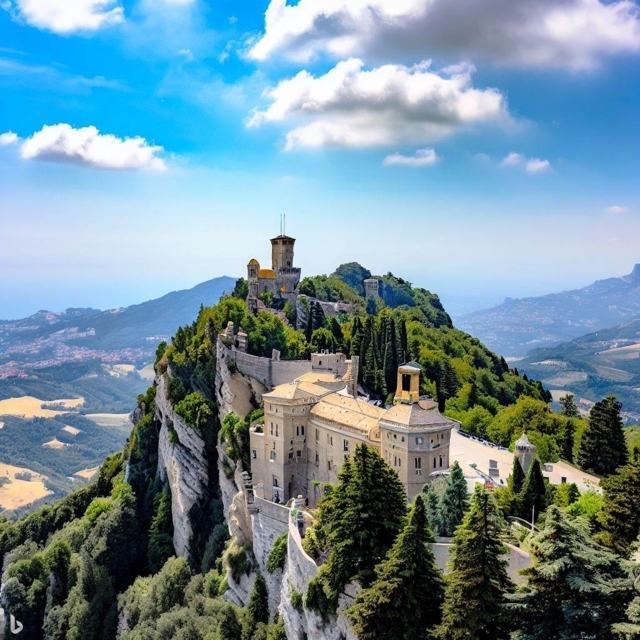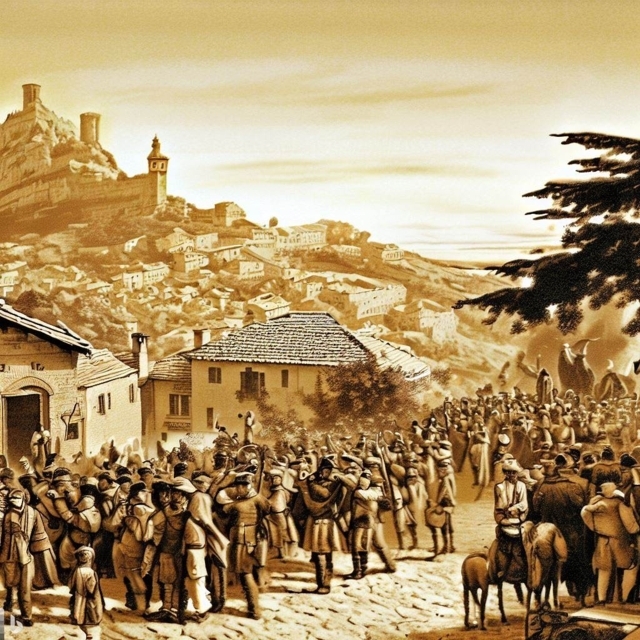Nestled in the Apennine mountains, surrounded completely by Italy, lies the tiny republic of San Marino. At just 61 square kilometres, it is one of the smallest countries in the world, yet it has maintained its independence for over 1700 years. How has this tiny state managed to survive untouched, despite its vulnerable location in the heart of Europe?
Tracing History
The origins of San Marino date back to the year 301 AD, when a Christian stonemason named Marinus fled the island of Arbe to escape persecution for his faith under the Roman emperor Diocletian. Marinus settled on Mount Titano and founded a small community of Christians. As the community grew, Marinus became known as San Marino, the founder of the settlement that bore his name.
In the following centuries, San Marino’s inaccessible location provided protection from invaders, while its policy of offering asylum to the oppressed saw its population swell with refugees. By the 13th century it had become a fully-fledged republic, electing its heads of state annually and writing its own statutes. Despite its diminutive size, San Marino managed to remain neutral and maintain its autonomy during the turbulent times that followed, when Italy was a collection of rival states.
A Clever Republic
A key factor in San Marino’s survival was its ability to negotiate favours from more powerful states in return for payments. For example, in 1291 they paid the Papal States for their independence, while also providing soldiers for Venice’s army. Later, deals were struck with the powerful families ruling nearby Rimini and Urbino for protection. Though San Marino was sometimes briefly occupied by armies, including Napoleonic forces in the early 19th century, foreign rulers invariably found it more trouble than it was worth to govern this remote mountain commune.
As Italy moved towards unification in the 19th century, San Marino was faced with a major threat to its survival. Yet even as the Kingdom of Italy formed around it, San Marino managed to uphold its autonomy by providing refuge to Italian political exiles, gaining favour with Italian nationalists who then ensured its continued independence. When Italy finally became a united country in 1861 under the House of Savoy, San Marino was left untouched.
The 20th century brought immense change to Europe, yet San Marino endured as ever. Its status as a neutral state was honoured during both World Wars, despite being surrounded by Fascist Italy under Mussolini in the Second World War. San Marino accepted thousands of refugees during this conflict, although it did suffer extensive Allied bombing in 1944 which killed 63 people.
San Marino in the Present Day
After the War, as Europe divided into Communist East and Capitalist West, San Marino positioned itself as a Western-aligned enclave within the Communist bloc, joining the Council of Europe in 1988 and the United Nations in 1992. Today it remains closely tied to Italy, using Italian currency, and depending heavily on tourism, yet staunchly preserves its ancient republican institutions and fierce sense of independence.
The fact that San Marino has maintained its freedom and self-governance for over 17 centuries, despite its tiny size, is truly remarkable. Key factors in its survival seem to be its impregnable mountain location, skilful diplomacy and favours with stronger powers, and providing asylum to the oppressed. Though ravaged by war and instability in its early years, the later development of the Italian state around it consolidated San Marino’s status. Its neutrality was mostly respected by the warring nations that engulfed Europe.
Against all odds, this minuscule republic held firm, tenaciously defending its liberty through shrewd politics. The spirit of its founder Marinus lives on today in the proud citizenship of its 30,000 inhabitants, staunchly proclaiming their right to self-determination against the tides of history. This underdog story of David and Goliath proportions shows how, with determination and fortitude, even the smallest player can withstand the march of mighty empires.
References
– Gilbert, C. (2020). The history of San Marino. Encyclopaedia Britannica. https://www.britannica.com/place/San-Marino-republic-Europe
– Beales, D. & Biagini, E.F. (2002). The Risorgimento and the unification of Italy. Routledge
– Mazower, M. (2004). Dark continent: Europe’s twentieth century. Penguin
– Gregory, D. (2021). San Marino. The Hutchinson unabridged encyclopedia. Helicon
Tags
Divi Meetup 2019, San Francisco
Related Articles
Unappreciated Greatness
Life and Legacy of Jahangir of the Mughal Empire. Jahangir ruled over one of the largest empires in human history during his lifetime, yet few people outside of South Asia have heard of him. I aim to shed light on the life and legacy of this remarkable figure,...
The Plague Doctor’s Diary
A Personal Account of the Turin Epidemic of 1656. I am writing this diary to record my experiences and observations as a plague doctor in Turin, the capital of the Duchy of Savoy, during the terrible epidemic that has afflicted this city and its surroundings since the...
The Timeless Beauty of Bustan
Unveiling the Secrets of Saadi Shirazi's Masterpiece.In the realm of Persian literature, few works have captured the essence of love, spirituality, and morality quite like Bustan (The Orchard) by Saadi Shirazi. This 13th-century masterpiece has left a lasting impact...
Stay Up to Date With The Latest News & Updates
Explore
Browse your topics of interest using our keyword list.
Join Our Newsletter
Sign-up to get an overview of our recent articles handpicked by our editors.
Follow Us
Follow our social media accounts to get instant notifications about our newly published articles.









